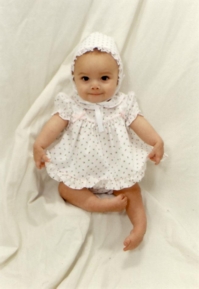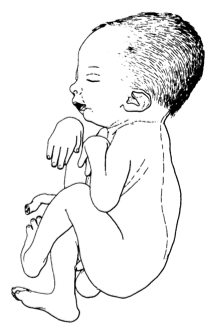Arthrogryposis Multiplex Congenita
Original Editors - Casey Sisk and Shelby White
Top Contributors - Casey Sisk, Jess Bell, Kim Jackson, Uchechukwu Chukwuemeka, Robin Tacchetti, Mande Jooste, Evan Thomas, Shelby White, WikiSysop, Rucha Gadgil, 127.0.0.1, George Prudden, Priyanka Chugh, Meaghan Rieke, Nupur Smit Shah, Elaine Lonnemann and Naomi O'Reilly
Introduction[edit | edit source]
Arthrogryposis Multiplex Congenita (AMC) "describes joint contractures in two or more areas of the body."[1] AMC is not a specific diagnosis. Contractures can be caused by a range of medical conditions; there are over 400 conditions associated with AMC.[1] If a congenital contracture forms in just one area, it is not AMC. Instead it is referred to as an isolated congenital contracture (e.g. clubfoot).[2]
AMC is a non-progressive condition of unknown cause, but it is associated with a lack of foetal movement - i.e the joint is initially forming as expected, but a lack of movement in utero causes extra connective tissue to form around the joint (fibrous ankylosis).[3][4] AMC is diagnosed at birth, and the primary impairments of children diagnosed with AMC are:[5]
- decreased joint movement in more than one joint
- decreased muscle strength and bulk
Prevalence[edit | edit source]
AMC occurs in around 1 in 3,000 live births.[1] It affects males and females almost equally and it occurs in Asian, African and European populations.[2]
There are a number of conditions associated with specific congenital contractures, such as clubfoot. The incidence of these conditions are higher as at least 1 in every 200 babies are born with a congenital contracture or stiff joint.[3]
The incidence of congenital contractures in infants at birth are:[3]
- Clubfoot: 1/500
- Congenital dislocated hips: 1/200 - 1/500
- All congenital contractures: 1/100 - 1/250
- Multiple contractures: 1/3000
Characteristics/Clinical Presentation[edit | edit source]
The signs and symptoms of AMC vary considerably from person to person.[2]As there are many conditions and syndromes that come under the umbrella of AMC, it can be helpful to use the following categories:[6]
- Amyoplasia
- Distal
- Other types of arthrogryposis
The prognosis of AMC depends on the cause of this condition, as well as the extent of contractures and other changes associated with the condition.[1]
It is estimated that around one-third of infants born with AMC will be still born or die before their first birthday.[6] In order to ensure the highest level of care for these infants, continual monitoring of their respiratory functioning is necessary.[4]
Clinical signs and symptoms of AMC include:[2][edit | edit source]
- Decreased or absent movement around small and large joints due to contractures
- Muscles of affected limbs are underdeveloped with decreased strength and bulk
- Long bones of the arms and legs are fragile
- Abnormally slender build
- Cleft palate
- Cognition may or may not be affected
- Around one-third of babies affected have structural or functional abnormalities of the central nervous system (CNS)
- Usually painless to the child[7]
Most Typical Presentations of AMC[edit | edit source]
- Flexed and dislocated hips, extended knees, clubfeet, internally rotated shoulders, flexed elbows, and flexed and ulnarly deviated wrists
- Abducted and externally rotated hips, flexed knees, clubfeet, internally rotated shoulder, extended elbows, and flexed and ulnarly deviated wrists[5]
Other possible effects of AMC include:[4][edit | edit source]
- Undescended testes
- Eating difficulties due to difficulty swallowing and jaw opening weakness
Systemic Involvement[edit | edit source]
AMC may be associated with the following:
- neurologic conditions including epilepsy, defects in neural migration, cerebral hypoplasia, holoprosencephaly, pyramidal tract degeneration, and olivopontocerebellar degeneration[8]
- congenital heart defect[8]
- respiratory problems[8]
Aetiology[edit | edit source]
The aetiology of AMC is unknown, but it is believed that this condition begins in the first trimester of pregnancy.[5] There are several theories on the cause of AMC, including:
- Decreased movement in utero allowing excessive connective tissue to form around the joints. This excessive connective tissue can result in the joint becoming fixed and/or limiting the movement of the joint. Decreased foetal movement can be caused by foetal crowding, secondary to maternal disorders (viral infections, drug use, trauma, or other maternal illness), and low levels of amniotic fluid around the foetus.[2]
- Genetic and environmental factors[8]
- Less commonly, can be associated with specific muscle conditions, including muscular dystrophy, some mitochondrial disorders, and congenital myopathies[2][8]
Differential Diagnosis[edit | edit source]
Because AMC is an umbrella term with more than 400 conditions associated with contractures, the differential diagnosis is extensive. he differential diagnosis of arthrogryposis is extensive. More than 400 conditions are characterized by this finding, and the features and severity can vary dramatically
AMC must be differentiated from other arthrogryposis types. There are approximately 150 other syndromes in this phenotype with stiff joints.[9] Other possible differential diagnoses include:[9]
- Bony fusion (symphalangism, coalition, synostosis)
- Contractural arachnodactyly (Beals syndrome)
- Multiple pterygium syndrome
- Lethal multiple pterygium syndrome
- Osteochondrodysplasias
- Distal arthrogryposis
- Freeman-Sheldon Syndrome
Diagnostic Tests[edit | edit source]
The diagnosis of AMC is most heavily founded based on the clinical examination and evaluation using characteristic symptoms and a detailed patient history. However, there are other tests that can be done to gather a more definite diagnosis including:
- Ultrasound- used to diagnose lack of foetal mobility and abnormal position in the womb[8]
- Nerve conduction, electromyography and muscle biopsy - diagnose myopathic or neuropathic disorder[2]
- Imaging studies of the central nervous system (CNS)[2]
- Comparative genomic hybridization (CGH) array[2]
- DNA Microarray[2]
- Exome studies[2]
Medical Management (current best evidence)[edit | edit source]
Surgical management of AMC is not the primary source for treatment. After therapeutic resources (physical therapy, orthotist, OT, SLP, geneticist, etc,) have been utilized, some joint contractures may still persist beyond the level of management these services can offer. This is usually when a surgical option is discussed in order to provide that individual with a better quality of life.
Orthopedic surgery can be done for the joint contractures that are resistant to therapy, stretching and casting. Surgical intervention may include osteotomies (bone cuts) and tendon/ muscle lengthening.[4] Interestingly, a unique trait to this disease, which can add complexity to treatment is that none of the musculoskeletal tissues that are surrounding the contracted joint are normal structurally.[10] If the child does have muscular limitation, tendon transfers have also been performed to improve the length tension relationship and the mechanics of the specific muscle.[2] If a tendon is causing a joint to be held in an abnormal position, a tenotomy can be performed to release the joint from the pull of the tendon. These procedures are usually assisted by capsulotomies as well.[11] One example of soft tissue reconstruction in a child with AMC would be using the pectoralis major muscle as an elbow flexor instead of the contracted biceps muscle to improve function of the UE.[11]
Due to the variability of where the contractures present in each child, other procedures can be carried out according to that body location such as talectomy for equinovarus in the foot.[12] Other research has been conducted on using a femoral-sciatic nerve block through either neurostimulation or ultrasound for distal arthrogryposis cases.[13]
If surgery is being discussed as an option for the child, it is important to consider factors that may affect the outcomes of that procedure. Soft tissue surgery, such as bone and tendon transfers, should be done early in life (ages 3-12 months). Other procedures such as opponensplasty or osteotomies should be performed later in life when the growth of that joint is near completed. With all surgeries, casting and bracing are suggested following these procedures for the best outcomes for the patients. [11]
Physical Therapy Management (current best evidence)[edit | edit source]
Physical therapy will be an important component of managing the effects of AMC in patients for the rest of their lives. One of the most important aspects of physical therapy is education, especially for the parents when the child is diagnosed with AMC. The main goal of physical therapy is to maintain maximum function and independence for the patient with AMC, while other goals can include improving joint motion and avoiding further muscle atrophy.
Physical therapy management for patients with AMC can include:
- Gentle joint manipulation[2]
- Management of removable splints for the knees and feet to assist in permitting regular muscle movement [2]
- Management of orthotics that can assist in gait and independence for children with AMC.[14]
- Serial casting of contracted joints[7]
- Strengthening the patient’s muscles, specifically the hip extensors, quadriceps, and shoulder depressors.[7]
- Stretching of joint and muscle contractures assists in promoting active muscle use to avoid immobilization.[15]
- Assist parents in initiating a stretching program for the family to do at home. It is recommended that stretching be done 3-5 times a day with 3-5 repetitions per set, with each stretch being held 20-30 seconds [5]
- Aquatic therapy [4]
- Hippotherapy[4]
- Teaching a patient how to use an assistive device such as a gait trainer, a walker, crutches, orthotics, etc.[4]
- Dynamic strengthening of the trunk
- Ambulation either independently or with an assistive device
- Specifically in infants physical therapy can include: gross motor skills (rolling, sitting, crawling, standing, walking, etc)[4], foot abduction braces, thermoplastic serial splinting, position activities such as stretching the hip flexors and prone positioning, and standing in a standing frame/stander.[5]
Resources[edit | edit source]
References[edit | edit source]
- ↑ 1.0 1.1 1.2 1.3 Society for Maternal-Fetal Medicine; Rac MWF, McKinney J, Gandhi M. Arthrogryposis. Am J Obstet Gynecol. 2019 Dec;221(6):B7-B9.
- ↑ 2.00 2.01 2.02 2.03 2.04 2.05 2.06 2.07 2.08 2.09 2.10 2.11 2.12 2.13 2.14 2.15 Hall JG. Arthrogryposis Multiplex Congenita - NORD (National Organization for Rare Disorders)Available from: http://rarediseases.org/rare-diseases/arthrogryposis-multiplex-congenita/ ( accessed 10 April 2016)
- ↑ 3.0 3.1 3.2 Staheli LT. Arthrogryposis: a text atlas. New York: Cambridge University Press; 1998 Available from: http://www.global-help.org/publications/books/help_arthrogryposis.pdf (accessed 10 April 2016)
- ↑ 4.0 4.1 4.2 4.3 4.4 4.5 4.6 4.7 AMCSUPPORT.ORG | Arthrogryposis Multiplex Congenita Support, Inc. Available from: https://www.amcsupport.org/about-us:accessed 2 April 2016)
- ↑ 5.0 5.1 5.2 5.3 5.4 Campbell SK, Palisano RJ, Orlin MN. Physical therapy for children. 4th ed. St. Louis, MO: Elsevier/Saunders; 2012. p313–32.
- ↑ 6.0 6.1 AMSCI. What is Arthrogryposis Multiplex Congenita (AMC)?. Available from: https://www.amcsupport.org/about-arthrogryposis (last accessed 24 April 2023).
- ↑ 7.0 7.1 7.2 Perajit E, Kamolporn K, Ekasame V. Walking ability in patients with arthrogryposis multiplex congenita. Indian Journal Of Orthopaedics. 2014; 48(4): 421-425.
- ↑ 8.0 8.1 8.2 8.3 8.4 8.5 Kalampokas E, Kalampokas T, Sofoudis C, Deligeoroglou E, Botsis D. Diagnosing Arthrogryposis Multiplex Congenita: A Review. ISRN Obstetrics & Gynecology. 2012;264918. doi: 10.5402/2012/264918
- ↑ 9.0 9.1 Gucev ZS, Pop-Jordanova N, Dumalovska G, Stomnaroska O, Zafirovski G, Tasic VB. Arthrogryposis multiplex congenital (AMC) in a three year old boy: differential diagnosis with distal arthrogryposis: a case report. Cases journal. 2009; 2:9403. doi: 10.1186/1757-1626-2-9403.http://casesjournal.biomedcentral.com/articles/10.1186/1757-1626-2-9403
- ↑ Graydon AJ, Eastwood DM. Orthopaedic Management of Arthrogryposis Multiplex Congenita. Springer Link. European Surgical Orthopaedics and Traumatology; 2014 Available from: http://link.springer.com/referenceworkentry/10.1007/978-3-642-34746-7_172 (accessed 10 April 2016)
- ↑ 11.0 11.1 11.2 Chen H. Arthrogryposis Treatment & Management: Medical Care, Surgical Care, Consultations. Medscape; 2015. Available from: http://emedicine.medscape.com/article/941917-treatment#d6 (accessed 10 April 2016)
- ↑ Chotigavanichaya C, Ariyawatkul T, Eamsobhana P, Kaewpornsawan K. Results of Primary Talectomy for Clubfoot in Infants and Toddlers with Arthrogryposis Multiplex Congenita. Journal Of The Medical Association Of Thailand = Chotmaihet Thangphaet. 2015; 98 Suppl 8S38-S41.
- ↑ Ponde V, Desai A, Shah D, Bosenberg A. Comparison of success rate of ultrasound-guided sciatic and femoral nerve block and neurostimulation in children with arthrogryposis multiplex congenita: a randomized clinical trial. Pediatric Anesthesia. 2013; 23(1): 74-78.
- ↑ Bartonek Å. The use of orthoses and gait analysis in children with AMC. Journal Of Children's Orthopaedics. 2015; 9(6): 437-447.
- ↑ Kimber E. AMC: amyoplasia and distal arthrogryposis Springer Link. Journal of Children's Orthopaedics; 2015. Available from: http://link.springer.com/article/10.1007/s11832-015-0689-1 (accessed 10 April 2016)








